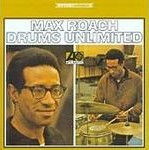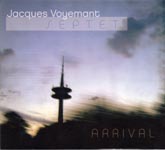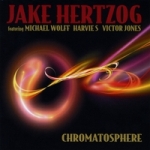Home » Jazz Articles » Interview » Jymie Merritt: Dedication Personified
Jymie Merritt: Dedication Personified
 Jymie Merritt came up in Philadelphia during the evolution of bebop and hard bop, when the town was a hotbed of musical activity. Players like John Coltrane, Benny Golson, and Philly Joe Jones were getting started there, and musicians like Charlie Parker, J.J. Johnson, Dizzy Gillespie and Miles Davis would come to the city to perform and to mentor them.
Jymie Merritt came up in Philadelphia during the evolution of bebop and hard bop, when the town was a hotbed of musical activity. Players like John Coltrane, Benny Golson, and Philly Joe Jones were getting started there, and musicians like Charlie Parker, J.J. Johnson, Dizzy Gillespie and Miles Davis would come to the city to perform and to mentor them.Merritt soon spread his "on the road" wings with Art Blakey and the Jazz Messengers, including some memorable recording dates, and then did seminal work with Max Roach, also playing with many other groups during that career-expanding period. During his extended stays in his home town, Merritt established workshops called "Forerunners," playing a major role in keeping the Philly jazz scene alive and well. He continues to do the workshops at age 83, still going strong as a musician, composer and mentor.
On July 12th, 2009, at the Jazz Fair produced by pianist and University of the Arts Division Head of Graduate Jazz Studies Don Glanden and sponsored by the university and the Philadelphia Jazz Heritage Project, Merritt, along with keyboardist Trudy Pitts, received an award for lifetime achievement.
That occasion prompted the following interview with him, which is filled with memories and perspectives that only a totally immersed and committed musician such as Merritt could bring with him to a conversation. As will be apparent in the interview, his love of the music is matched only by his personal warmth and introspective intelligence.
Chapter Index
- Favorites and beginnings
- Jazz Messengers and the Max Roach Group
- A struggle with cancer
- What keeps him going
- Jazz Messengers and the Max Roach Group
AAJ: Who are some of your favorite musicians to listen to?
JM: OK. I like Duke Ellington, Miles Davis, Oscar Pettiford.
AAJ: Who are your favorite bassists?
JM: I would say Oscar Pettiford and Ray Brown.
AAJ: What about some favorite recordings?
JM: Well, Charlie Parker—just about everything he did with Miles Davis and Dizzy Gillespie also comes to mind.
AAJ: You came up in the bebop era, right?
JM: Actually, before then. My favorites back then and now included Count Basie, Lester Young, Coleman Hawkins, Art Tatum, and Benny Goodman. That's early on. I started listening to jazz in the early thirties. I also listened to recordings from before that period, such as Louis Armstrong, Bix Beiderbecke, and Duke Ellington in particular.
AAJ: What made you choose the bass as an instrument?
JM: I guess my main influences were John Kirby, who had a radio broadcast, and Duke Ellington's bassist, Jimmy Blanton. And then with the Basie band, there was Walter Page and his 4/4 approach. And of course, Slam Stewart.
AAJ: You and Trudy Pitts are going to receive the Philadelphia Jazz Heritage Project awards for your respective lifetime contributions to jazz in Philadelphia. What are your thoughts about receiving this award?
JM: I'm sort of flabbergasted. Last year, I received the Don Redman Heritage Award at Harpers Ferry, W. Va. But that was a different sort of award. I was kind of surprised about the local Philly response, because I was never active in later years in Philadelphia other than the workshops I ran at various churches in the '60s.
AAJ: Could you just tell us a bit about the Harpers Ferry award?
JM: They have a jazz festival each summer at the site of the John Brown memorial. The award was related to some of the recordings I've made. These were recordings with prominent groups. I've never recorded with my own group, and people have been asking me to do so.
AAJ: Are you starting a group of your own now?
JM: I've had my own group since the '60s. We've been playing together locally, but we haven't recorded. I just took a year off to write some new music, which we haven't played before and we're going to record that. So the music is complete, I have a new band-book, and we're getting together to rehearse it.
AAJ: What kind of group is it?
JM: Right now it's only five pieces. On keyboard, we have Colmore Duncan. On drums, there's Alan Nelson. Terry Lawson is on tenor sax. And Warren McLendon is the second keyboardist. Warren is actually a percussionist and we're using the keyboard in a different way. Of course, I'm the bassist.
AAJ: Would it be accurate to say that you've lived in Philadelphia most of your life?
JM: I was born here in 1926. I joined the Army in 1943 and returned to Philadelphia in 1946. Then, I went on the road in 1949 and ended up in New York City. For 12 years, I lived between NYC and Philly. I returned permanently to Philly in the 1970s and have been working here ever since.
AAJ: Having lived here for a good deal of your life, what is your take on jazz in Philadelphia? Do you like the younger generations of musicians here? Do you think there's enough opportunity to play jazz here? What are your views on the Philadelphia jazz scene as it is today?
JM: I think there was a time when there was more of a scene here that led to a proliferation of music because there were many places to perform and the musicians could develop their skills right here. I was just talking to my friend the drummer Charlie Rice—he's a little older than I am—and we were reflecting that nowadays there aren't many places to play.
And so people have to figure out ingenious ways to get their music performed and heard. In the past, there were times when there were quite a few places and you could keep working. And there was an ongoing network scene, with an exchange of information, and I remember that time vividly because there were a number of music schools, and all the guys were studying: Trane, Philly Joe Jones, and so on. So, everyone was studying and playing.
AAJ: You're talking about one of the most fruitful periods in the history of jazz, and especially in Philadelphia. I understand that Charlie Parker would come down here, Miles Davis, and so on.
JM: Yes, they would come over almost weekly at one time.
AAJ: From what I understand, there were two general gathering places. One was in various homes for rehearsals. I think McCoy Tyner had people over to his mother's hair salon. The family of vocalist Miss Justine used to have musicians at their house. That's an amazing phenomenon—hasn't happened that often, that groups were often rehearsing in their homes, and you had guys like Trane, Benny Golson and Red Garland around. I suppose that was the equivalent of the more recent rock bands rehearsing in people's garages and basements.
 JM: We'd often rehearse at my house. Jimmy Heath's big band would come around.
JM: We'd often rehearse at my house. Jimmy Heath's big band would come around.
AAJ: A big band rehearsal in your house?
JM: We had a very large house. When we'd finish a gig, everyone would still want to play, so we'd go to my house. We got together regularly on Sunday afternoons for quite a few years. We'd serve some fried chicken. And we'd just blow.
AAJ: That sounds like great fun and very productive at the same time. Another general location at around the same time, as I understand it, was on Columbia Avenue [now Cecil B. Moore Boulevard- eds.] in North Philadelphia near Temple University. There was a restaurant called Linton's.
JM: Oh, yeah. Right on Broad Street off Columbia Avenue.
AAJ: Yes, exactly. And were you involved with the guys who used to gather there?
JM: Yeah. I used to eat there. And when we'd finish eating, we'd leave a tip. And then Philly Joe would go around and collect the money for himself as we went out the door. [laughter]
AAJ: So he'd keep the tips!
JM: He was really ingenious.
AAJ: Who else was there besides Philly Joe?
JM: I remember tenor saxophonist Jimmy Oliver. He was playing at a place called The Downbeat at 11th and Ludlow. You could actually hear him when you got off the El train at 11th and Market. He was such a celebrity that he did very well in Philadelphia. He drove around in a super-charged car, I think an Austin or something. When he'd step out of that car, people would gather around him around the block—and that would continue for years. Wherever Jimmy Oliver was, you'd find Red Garland, Philly Joe, and most of the top players. He would also work at a place at the end of Ridge Avenue called the Point. And down from there was the Zanzibar, where they brought in mainstream players like Charlie Ventura, Coleman Hawkins, Bird and Bud Powell.
AAJ: What an exciting time that was! Did Oliver make any recordings?
JM: He did a thing locally called "Oliver's Twist." That was back in the '40s and he anticipated the dance by that name. He didn't record much, never left Philly. He played a Lester Young-style horn. He was very original, maybe the most original player I ever heard in Philadelphia. I think he was a natural, largely self-taught on the instrument.
AAJ: Guys like him are sometimes flamboyant, but they inspire and motivate their peers.
JM: They all loved him. The other musicians followed him around like the Pied Piper. And there was the Woodbine Club, the primary club in Philly, and everyone would play there on Sundays when the regular bar was closed. That happened often, so there was playing goin' on most of the time back then.
Jazz Messengers and the Max Roach Group
AAJ: You emerged onto the world jazz scene with Art Blakey's Jazz Messengers.
JM: I feel that my hooking up with Blakey was in a sense divine providence.

AAJ: How did you actually meet Art Blakey?
JM: I think it was the 4th of July, 1958. I was sitting around in Philly with nothing to do, and decided to go to New York and see what the guys were doing there. I started walking up Seventh Avenue and saw Small's Paradise, which had a sign in the window: "The Jazz Messengers." I went in and sat at the bar while they were playing, and after the set, Art comes over to me and totally out of the blue says, "Would you like to work for me?" And I said, "Yeah!" And that was it! I still don't understand that to this day. Maybe someone in the band said something to him, but he just walked right up and asked me. I told him I was playing Fender bass guitar with a rock band, but that didn't seem to phase him. But I played upright bass with the Jazz Messengers, although a couple of times I let him hear me on the Fender.
AAJ: Many of the greats in jazz got their big break with Blakey. They are all very devoted to him in retrospect. He mentored the young guys in his groups, brought them up, brought them along. What's your recollection of Blakey? What was it about him that was so inspirational?
JM: Well, I was a little older than most of the guys in our group. I was in my late 20s or early 30s, but the first thing you realized about him was that he was extremely focused. He had a true sense of jazz, a real "messenger," so to speak. He recollected the time when he was involved in the Muslim movement, and then after a while he wondered what his personal "message" was, and he tried to put that into the music. It's similar to the earlier leaders I'd go and hear in Philadelphia who would infuse so much into the bands. He had a spiritual side, and it was uncanny how he would identify just what needed to be done, and it just happened.
Blakey was from Pittsburgh, and there was a serious jazz scene there as there was in Philly. I went to Pittsburgh to play with him, and then returned there many times to play with both him and Max Roach. There was something great about the jazz scene there at that time, and some of the best players came from that area, like Ray Brown and Mary Lou Williams.
AAJ: Speaking of Max Roach, I have always imagined that playing for him would be very difficult on account of the complexity of his musical ideas. Is that a correct assessment?
JM: Yes, it was very challenging, but it was very engaging. There was a lot to learn from him, and the way he brought it to your attention was always by indirection, never direct instructions. I learned a lot from him, and he invited me back at a later time, but I had contracted cancer, so I was unable to return to the group.
A struggle with cancer
AAJ: You're a cancer survivor. About how long did you struggle with it?
JM: For about 20 years.
AAJ: That's a long haul. But I presume you were performing during a good deal of that time?
JM: Yes, I was. Actually, I wasn't sure what it was for a long time.
AAJ: What enabled you to recover?
JM: For one thing, my third wife—we've been together almost 30 years—had such faith in me that I was inspired to persevere. I had never abused drugs like some of the other musicians, and that was a plus. I went on special diets like macrobiotics, and that enabled me to improve my level of functioning until I met a doctor who did a CT-scan, which was less common at that time, and they located the tumor. So from then on, in the mid-1980s, I was able to get treatments. Now I'm doing great, and I feel like a 20-year-old. I want to get out there with the young musicians. I'm listening to a high school band over in Camden, N.J.
AAJ: I wanted to ask you what you think of some of the up-and-coming players.
JM: Some of them are coming up so young—in their teens! And they are really dedicated and serious. In fact, the guys in their 20s are the older generation now! They're pursuing their careers. One guy went and got a doctorate, and that's happening more often.
AAJ: Yes, and you can see how these guys are able to bring in all the traditions—they know the whole jazz legacy and are able to incorporate it in their playing. In fact, your son, Michael is a bassist, and what about your daughter, Mharlyn?
JM: She's my oldest, and a singer. She's back in Philadelphia now and starting a group of her own, which she once had here back awhile.
AAJ: When they were growing up, did you try to interest them in music?
 JM: No, I didn't. I tried not to influence them in any way. And I was astounded that all my kids pursued music, and a couple of them became professionals.
JM: No, I didn't. I tried not to influence them in any way. And I was astounded that all my kids pursued music, and a couple of them became professionals.
AAJ: How many children do you have?
JM: I have six children, five by my first marriage and one by a later marriage. I have no children by my third marriage, only a cat [Laughter].
AAJ: A different kind of "cat." Now, I've heard of this group project you do called the "Forerunners." They apparently were doing a lot of good things, but I don't know if they're still going. Could you tell us about them?
JM: Well, when I stopped going on the road, I wanted to bring some of the energy of the Jazz Messengers into Philly. So I started a workshop at the Tuskegee Clubhouse, and I got Kenny Lowe, the late, gifted pianist, the drummer Donald Bailey (we called him Duck), singer September Wrice and the saxophonist Odean Pope. And we kept it going for five years until I went with Max Roach.
AAJ: So the "Forerunners" was an ongoing workshop.
JM: Yes, and then we got to play on Sundays at Father Paul Washington's church, and I used that opportunity to go beyond the kind of bass playing I'd been exposed to, in order to develop new forms and build from that.
AAJ: What kind of ensembles do you write for?
JM: I write for registers and voicing, rather than particular instruments. In the past, I wrote for bands as large as 18 pieces, but now I'm writing just for the five people in my current group. We're trying to develop a different attitude that is yet deeply involved in the traditional music.
AAJ: Have you been influenced by Ornette Coleman?
JM: No, not especially. I did come through that period, and we did quite a bit in that area. There were always players that were on the edge. What Ornette did was to bring attention to the validity of experimentation, because a lot of the innovators were shunned.
AAJ: Am I correct that you are coming out with a recording of your compositions?
JM: I have my own record company and a small studio where I live, and I'm hoping to record a lot of the musicians in the Philadelphia area using my own music for those who want to play it. I hope to distribute my music widely, especially for the younger people to perform it.
AAJ: Will there be any live opportunities to hear your compositions?
JM: Well, we're going to do a couple of them at the Jazz Fair on July 12th at the University of the Arts.
What keeps him going
AAJ: Now, how old did you say you were?
JM: I'm 83, if I'm not mistaken.
AAJ: It's hard to keep track after a while. [Laughter.] To me, you seem ageless, perennially young in spirit. What's your secret?
JM: I have a friend who just underwent a serious operation, and he said that the only thing that kept him going was the music, and I agree. This music, going all the way back to Louis Armstrong—it gives you something wonderful, and I'm hopeful we can bring it forward to a new generation to experience.
AAJ: Jazz is so full of life.
JM: It's revitalizing—I "take one" every day [Laughter].
AAJ: It's your medication, so to speak. So, what have you got in line for the near future?
JM: Well, my group is rehearsing twice a week now, getting ready to perform, and to engage and bring in some younger people. And I expect to continue to stay in touch with the Creative Arts High School in Camden—and the young people generating some of that musical energy that we used to have in our neighborhoods back then.
AAJ: That was a sort of Renaissance period in Philly jazz. Nowadays, we have some fantastic musicians, but the atmosphere and passion aren't quite the same.
JM: We had a great leader then in the form of Charlie Parker, who was a hero despite the adversity from his drug addiction. Guys like him helped all the younger guys pull it all together. I remember going up to New York, and there was a restaurant at 52nd and Broadway, and after the gigs, everyone would gather there. Like, I remember Thelonious Monk sitting over there in a corner. Benny Golson, Gigi Gryce, Paul Gonsalves, everyone you could think of would be in there. It was right down the street from Roseland and the musician's union, right around the corner from Birdland. There was tremendous energy, even after you got through playing. A little bit later, Monk came out with "Brilliant Corners"—I like to think it came from him musing that night.
Selected Discography
Art Blakey, Moanin'(Blue Note, 1958)
Art Blakey, A Night in Tunisia (Blue Note, 1960)
Art Blakey, Mosaic (Blue Note, 1961)
Art Blakey, The Freedom Rider (Blue Note, 1961)
Art Blakey, Three Blind Mice (United Artists, 1962)
Max Roach, Drums Unlimited (Atlantic, 1965)
Max Roach, Members, Don't Git Weary (Atlantic, 1968)
Lee Morgan, Live at the Lighthouse (Blue Note, 1970)
Photo Credit
Page 1: Francis Wolfe/Mosaic Images
Tags
PREVIOUS / NEXT
Support All About Jazz
 All About Jazz has been a pillar of jazz since 1995, championing it as an art form and, more importantly, supporting the musicians who make it. Our enduring commitment has made "AAJ" one of the most culturally important websites of its kind, read by hundreds of thousands of fans, musicians and industry figures every month.
All About Jazz has been a pillar of jazz since 1995, championing it as an art form and, more importantly, supporting the musicians who make it. Our enduring commitment has made "AAJ" one of the most culturally important websites of its kind, read by hundreds of thousands of fans, musicians and industry figures every month.






















